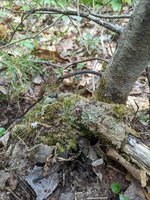TCEvan
Yamadori
I found a white pine that seems like it has some potential that I want to explore a little more. I only had a moment to check out the tree when I found it before my 2 and 4 year old came running up and I had to divert their attention elsewhere.
The nebari/trunk base is fairly covered with moss/lichen. I'm wondering when, how, and what quantity of this to remove.
I'm planning to cut half the roots after the needles harden off this year. Then maybe the other half next year if it responds well, otherwise I'll wait. So it will be in the woods for at least another year or two. I'm assuming wait on any moss work until after I remove it?

The nebari/trunk base is fairly covered with moss/lichen. I'm wondering when, how, and what quantity of this to remove.
I'm planning to cut half the roots after the needles harden off this year. Then maybe the other half next year if it responds well, otherwise I'll wait. So it will be in the woods for at least another year or two. I'm assuming wait on any moss work until after I remove it?


